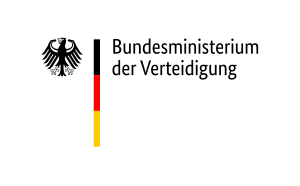Ministry of Defence of Germany facts for kids
| Bundesministerium der Verteidigung | |
 |
|
| Agency overview | |
|---|---|
| Formed | 7 June 1955 |
| Jurisdiction | Government of Germany |
| Headquarters | Bonn, Nordrhein-Westfalen |
| Employees | 3730 |
| Minister responsible |
|
| Website | bmvg.de |
The Federal Ministry of Defence (BMVg) is a Ministry of the Federal Republic of Germany. At present the headquarters of the ministry are still in Bonn with 3230 working in the Hardthöhe. The second office employs about 500 people in the Bendlerblock in Berlin.
Organisation
The BMVg is at the highest Federal authority and the highest command authority of the defence forces. The BMVg has civilian and military departments:
- the General staff (Führungsstab)of the defence forces, under the Inspector General of the Federal Armed Forces
- the top staffs of the 3 forces (Army, Navy and Air Force)
- the armaments department the department of defence administration, infrastructure and environmental protection
- the personel, social and central department
- the legal department
- the Budget department
- the department for modernisation.
Operatively the General Staff of the Defence Forces (or "FÜ S", which is short for German: Fuhrungsstab der Streitkräfte) is the most important, it has seven sections divided into 42 smaller sections
The press and information staff and the planning staff work directly under the minister
Federal Minister of Defence
In peace time the Federal Minister of Defence is commander in chief of the Armed Forces, not the Federal President.
If Germany is attacked, or about to be attacked, command passes to the Chancellor.
History
In 1950 Chancellor Konrad Adenauer gave Theodor Blank the job of preparing for the time when Germany could have an army. In December 20 people where working in the "Blank Office". On 7 June 1955 it had 1300 employees, and it became the Federal Ministry for Defence.
It was renamed in Federal Ministry of defence on December 1961 and was seen as one of the "classic departments" . At German reunification the National People's Army (Nationale Volksarmee) of East Germany was made part of the Federal Armed Forces. Not long after this, Germany's army took part in the war in Kosovo. This was the first time that Germany's army had been sent to fight outside Germany since the end of World War II
Federal Ministers of Defence since 1955
| German Ministers of Defence | |||||
|---|---|---|---|---|---|
| No | Name | Life data | Term start | Term end | Party |
| 1 | Theodor Blank | 1905-1972 | 7 June 1955 | 16 October 1956 | CDU |
| 2 | Franz-Josef Strauß | 1915-1988 | 16 October 1956 | 11 December 1962 | CSU |
| 3 | Kai-Uwe von Hassel | 1913-1997 | 11 December 1962 | 1 December 1966 | CDU |
| 4 | Gerhard Schröder | 1910-1989 | 1 December 1966 | 21 October 1969 | CDU |
| 5 | Helmut Schmidt | 1918-2015 | 21 October 1969 | 10 July 1972 | SPD |
| 6 | Georg Leber | 1920-2012 | 10 July 1972 | 1 February 1978 | SPD |
| 7 | Hans Apel | 1932-2011 | 17 February 1978 | 1 October 1982 | SPD |
| 8 | Manfred Wörner | 1934-1994 | 4 October 1982 | 18 May 1988 | CDU |
| 9 | Rupert Scholz | 1937- | 18 May 1988 | 21 April 1989 | CDU |
| 10 | Gerhard Stoltenberg | 1928-2001 | 21 April 1989 | 31 March 1992 | CDU |
| 11 | Volker Rühe | 1942- | 1 April 1992 | 26 October 1998 | CDU |
| 12 | Rudolf Scharping | 1947- | 28 October 1998 | 19 July 2002 | SPD |
| 13 | Peter Struck | 1943-2012 | 19 July 2002 | 22 November 2005 | SPD |
| 14 | Franz Josef Jung | 1949- | 22 November 2005 | 27 October 2009 | CDU |
| 15 | Karl-Theodor zu Guttenberg | 1971- | 28 October 2009 | 3 March 2011 | CSU |
| 16 | Thomas de Maizière | 1954- | 3 March 2011 | 17 December 2013 | CDU |
| 17 | Ursula von der Leyen | 1958- | 17 December 2013 | 17 July 2019 | CDU |
| 18 | Annegret Kramp-Karrenbauer | 1962- | 17 July 2019 | Present | CDU |

